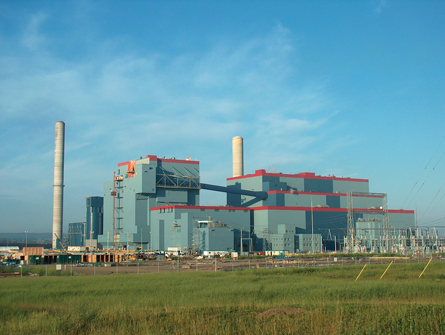Module 3
1. Module 3
1.41. Lesson 6
Module 3—Electrical Phenomena
Lesson 6—The Motion of Charges in Uniform Electric Fields
 Get Focused
Get Focused

© Epcor Utilities Inc.
The Genesee power plant at Wabamun Lake near Edmonton, Alberta, can generate 1.315 billion watts of power. To put that into perspective, this is enough power to supply the electrical energy needs of nearly 1.5 million homes in Alberta! The source of all this energy is coal from nearby surface mines. The coal seen in the next photo is being delivered, via conveyor, to a supercritical boiler, where it is crushed and mixed with oxygen at high pressure before being burned.

© Michel Stevelmans/shutterstock
The useful energy output from the boiler is in the form of high-pressure steam. The steam is used to drive the turbines connected to the generators that produce electricity.
Electricity generating stations that burn pulverized coal as fuel often have particulate matter, such as bits of uncombusted coal, in the exhaust gas that leaves the furnace. This exhaust gas is called flue gas, and the particulate matter in flue gas can be a significant source of air pollution if it is not removed before entering the environment.
There are technologies designed to remove particulate matter from flue gas. The most common technology is called an electrostatic precipitator. This device works by first charging the tiny particles in the flue gas and then by removing these particles using strong electric fields.
How strong would the electric fields have to be to effectively remove over 99% of the particulate matter from the flue gas? The answer to this question depends on typical values for charge, mass, and initial velocity for individual particles. In other words, the answer depends on combining what you have been learning about electrostatics in this lesson, along with the physics of Newton's laws and projectile motion from previous courses.
In this lesson you will answer the following essential questions:
- How do charged particles move in a uniform electric field? How is this motion similar to a mass moving in a gravitational field?
- Is it possible to predict the velocity, acceleration, and displacement of charged particles moving in electric fields?
 Module 3: Lesson 6 Assignments
Module 3: Lesson 6 Assignments
Your teacher-marked Module 3: Lesson 6 Assignment requires you to submit a response to the following:
- Lab—LAB 1, LAB 2, LAB 3, LAB 4, LAB 5, LAB 6, and LAB 7
- Assignment—A 1 and A 2
You must decide what to do with the questions that are not marked by the teacher.
Remember that these questions provide you with the practice and feedback that you need to successfully complete this course. You should respond to all the questions and place those answers in your course folder.